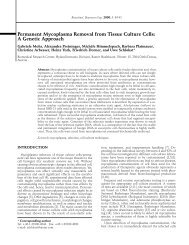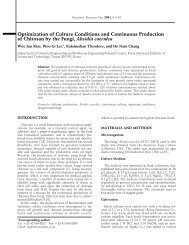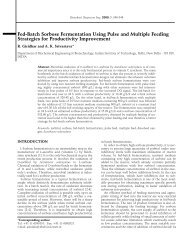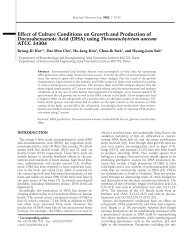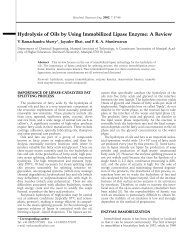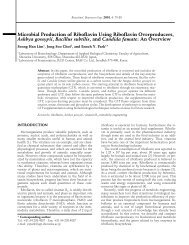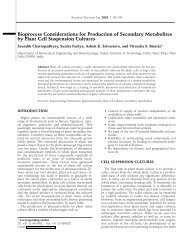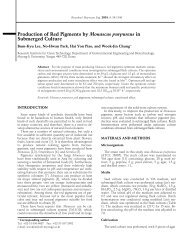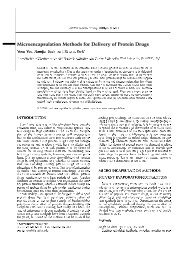Microencapsulation Methods for Delivery of Protein Drugs
Microencapsulation Methods for Delivery of Protein Drugs
Microencapsulation Methods for Delivery of Protein Drugs
Create successful ePaper yourself
Turn your PDF publications into a flip-book with our unique Google optimized e-Paper software.
Biotechnol. Bioprocess Eng. 2001, Vol. 6, No. 4 217<br />
suspension<br />
<strong>Protein</strong><br />
polymer solution<br />
in<br />
Liquid nitrogen<br />
Frozen<br />
microspheres<br />
4. Schematic diagram <strong>of</strong> the ProLease Fig. ® encapsulation<br />
From reference [22].<br />
process.<br />
<strong>for</strong>mulation using this method (referred to as<br />
hGH<br />
ProLease ® was approved by the FDA in December 1999,<br />
)<br />
an injectable suspension <strong>for</strong> once- or twice-a-month<br />
as<br />
under a brand name <strong>of</strong> Nutropin depot adminitration, ® .<br />
this process, all manipulations are per<strong>for</strong>med at<br />
In<br />
temperatures, there<strong>for</strong>e thermal denaturation <strong>of</strong><br />
low<br />
drugs can be prevented. There are no aqueous<br />
protein<br />
thus the protein is not subjected to oil-water<br />
phases,<br />
where some proteins may denature. In addi-<br />
interfaces<br />
the process utilizes solvents in which most protion,<br />
are insoluble (dichloromethane as a polymer solteins<br />
ethanol as an extraction solvent), there<strong>for</strong>e a high<br />
vent,<br />
efficiency can be achieved [22,27]. How-<br />
encapsulation<br />
this system is not easy to apply to various protein<br />
ever,<br />
The use <strong>of</strong> liquid nitrogen also makes scale-up<br />
drugs.<br />
difficult. The system still utilizes toxic organic<br />
rather<br />
and thus it has similar problems associated<br />
solvents,<br />
solvent evaporation/extraction methods.<br />
with<br />
PHASE SEPARATION (COACERVATION)<br />
<strong>Methods</strong><br />
Nozzle<br />
Extraction solvent<br />
Atomized<br />
droplets<br />
<strong>of</strong> solvent<br />
Extraction<br />
microspheres<br />
from<br />
Drug particle<br />
Release modifier<br />
PLG microsphere<br />
by phase separation is basically a<br />
<strong>Microencapsulation</strong><br />
process: (1) phase separation <strong>of</strong> the coating<br />
three-step<br />
to <strong>for</strong>m coacervate droplets; (2) adsorption <strong>of</strong><br />
polymer<br />
coacervate droplets onto the drug surface; and (3)<br />
the<br />
<strong>of</strong> the microcapsules [28], as shown in Fig.<br />
solidification<br />
Phase separation techniques can be classified accord-<br />
5.<br />
to the method to induce phase separation; noning<br />
addition, temperature change, incompatible<br />
solvent<br />
or salt addition, and polymer-polymer interac-<br />
polymer<br />
[29]. tion<br />
Addition<br />
Non-solvent<br />
polymer to be coated is dissolved in a good sol-<br />
The<br />
and drug may be dissolved or suspended or emulvent,<br />
in the polymer solution. Then the first nonsified<br />
(also called ‘coacervating agent’ or ‘phase insolvent<br />
which is miscible with the good solvent but<br />
ducer’)<br />
not dissolve the polymer is slowly added to the<br />
does<br />
solution system. The polymer is concen-<br />
polymer-drug<br />
as the solvent <strong>for</strong> the polymer is slowly extracted<br />
trated<br />
the first non-solvent. The polymer is then induced<br />
into<br />
by<br />
Induced<br />
Non-solvent<br />
1.<br />
Temperature change<br />
2.<br />
Salt / Incompatible polymer<br />
3.<br />
4. Polymer-polymer interaction<br />
separation<br />
Phase<br />
the coating polymer<br />
<strong>of</strong><br />
Drug particle<br />
<strong>of</strong><br />
Adsorption<br />
droplets<br />
coacervate<br />
<strong>of</strong><br />
Solidification<br />
microcapsules<br />
the<br />
5. Schematic diagram <strong>of</strong> the <strong>for</strong>mation <strong>of</strong> a coacervate<br />
Fig.<br />
From reference [30].<br />
microcapsule.<br />
phase separate and <strong>for</strong>m coacervate droplets that<br />
to<br />
the drug (Fig. 6(A)). The coacervate droplet size<br />
contain<br />
be controlled by adjusting the stirring speed. At this<br />
can<br />
<strong>of</strong> the process, the coacervates are usually too s<strong>of</strong>t<br />
point<br />
be collected, and thus they are usually transferred to<br />
to<br />
large body <strong>of</strong> a second non-solvent (also called ‘hard-<br />
a<br />
agent’) to harden the microparticles [31].<br />
ening<br />
polyesters, such as PLA and PLGA, are used,<br />
When<br />
widely used solvents are dichloromethane, ethyl<br />
most<br />
and acetonitrile. The first non-solvents <strong>for</strong> the<br />
acetate,<br />
are low-molecular weight liquid polybutadi-<br />
polymers<br />
low-molecular weight liquid methacrylic polymers,<br />
ene,<br />
oil, vegetable oil, and light liquid paraffine oils.<br />
silicone<br />
hydrocarbons, such as heptane, hexane, and<br />
Aliphatic<br />
ether, have been used as the second non-<br />
petroleum<br />
solvent.<br />
Change<br />
Temperature<br />
system comprised <strong>of</strong> a polymer and a solvent exists<br />
A<br />
a single phase at all points above the phase boundary.<br />
as<br />
is dispersed in the polymer solution with stirring.<br />
Drug<br />
the temperature is decreased below the curve (Fig.<br />
As<br />
phase separation <strong>of</strong> the dissolved polymer occurs<br />
6(B)),<br />
the <strong>for</strong>m <strong>of</strong> immiscible liquid and the polymer coa-<br />
in<br />
around the dispersed drug particles, thus <strong>for</strong>ming<br />
lesces<br />
Further cooling accomplishes gelation<br />
microcapsules.<br />
solidification <strong>of</strong> the coating. The microcapsules are<br />
and<br />
from the solvent by filtration, decantation, or<br />
collected<br />
techniques [32].<br />
centrifugation<br />
Polymer Addition or Salt Addition<br />
Incompatible<br />
two chemically different polymers dissolved in<br />
When<br />
common solvent are incompatible and do not mix in<br />
a<br />
phase separation takes place. This phenome-<br />
solution,<br />
is well described by the phase diagram <strong>of</strong> a ternary<br />
non<br />
consisting <strong>of</strong> a solvent, and two polymers, X<br />
system<br />
Y (Fig. 6(C)). A drug is dispersed in a solution <strong>of</strong><br />
and<br />
Y (point a in Fig. 6(C)) and polymer X is added<br />
polymer<br />
the system, denoted by the arrowed line. When the<br />
to<br />
boundary is passed with the further addition <strong>of</strong><br />
phase<br />
X, polymer rich phase begins to separate to<br />
polymer<br />
immiscible droplets containing the drug, and coa,-<br />
<strong>for</strong>m





